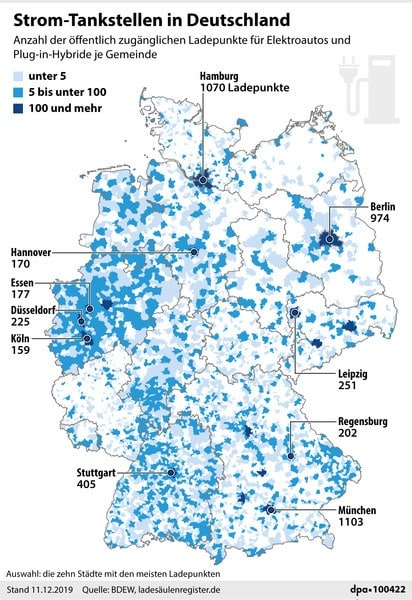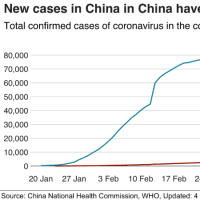2020年1月11日(Sat.) 各国が速報で伝えています、イランが誤って旅客機を撃墜したことを認めたと。思うに、暴力・武力は悲劇を生み出すだけです。各国共に対話外交を最重視すべきです。但し、虚言に満ちた美辞麗句には誰も耳を傾けないでしょう。信頼は、普段の言動から培われるもので、言っていることとやっていることが真逆やチグハグであったり、誰かの顔色を窺った追従外交や判断では誰も信頼を寄せません。
*
さて、ドイツのエレクトリックカー普及への取り組みは、日本とは大違いのようです。(ニュースソース: THE LOCAL.de 1月10日発 )
<原文の一部>
How Germany is preparing for the rise of the electric car
ドイツは、増加するエレクトリックカーへの準備をどのようにしているか。

A photo of an electric car marks the parking spot next to a charging station in Hanover. Photo: DPA(ハノーバーにて)
Electric cars and hybrids are a major part of Germany's climate policy. Are government officials and energy sector leaders doing enough? A deeper look.
エレクトリックカーとハイブリッドはドイツの気候変動に関する主要な位置付けにあります。政府やエネルギー部門の責任者の行動は十分でしょうか? 詳しく見てみましょう。(意訳)
Germany has made significant progress in building charging points for electric cars, but major regional differences still remain.
While cities and metropolitan areas have a comparatively large number of charging stations, there are still many "white spots" in the countryside.
These are the results compiled by the Energy Association BDEW and shared with the DPA and the "Süddeutsche Zeitung.”
Overall, the association describes the expansion of the charging infrastructure as “vigorous” and “dynamic.”
The plans come as American electric car giant Tesla sets out work to build its first European factory outside of Berlin by 2021.
Several German car manufacturers have furthermore announced plans to increase their share of electric cars in the coming years.
(抜粋)ドイツはエレクトリックカーの充電ステーションの設置を果敢に進めています。しかし、未だ地域格差が残ります。
都市レベルでは比較的多くの充電ステーションがありますが、地方に於いては空白地域も多くあります。関係機関が諸データを集めました。全体的には、充電に関するインフラは劇的に広がっています。USのテスラは、ヨーロッパでの工場を2021年までにベルリン郊外に建設します。また、ドイツのいくつかの自動車メーカーは、ここ数年でエレクトリックカーの割合を増大させる計画です。
At the end of 2019 there were around 24,000 public charging points in Germany, or almost 50 percent more than in the previous year.
Quick charging stations account for around 15 percent of these ports, according to the BDEW’s register. To compare, there are currently around 220,000 electric cars and plug-in hybrids in the Germany.
This means that, on average, nine e-cars or plug-in hybrids exist for every charging point.
Eighty percent of charging processes take place at home or at work.
“It is crucially important that the hurdles for building a charging infrastructure are finally removed in the private sector. Politicians should put this high on their agenda for the new year,” BDEW General Manager Kerstin Andreae said.
In the coming years, electric cars are expected to make a breakthrough on the mass market.
(抜粋)2019年末の時点で、ドイツには約24,000カ所の充電ポイントがあり、前年(2018年)に比べて50%は増加しています。
急速充電ステーションは約15%になっています。そして対比すると、現在、約220,000台のエレクトリックカーとプラグインタイプがドイツで走っています。(意訳)
これは平均で言うと、9台のエレクトリックカーとハイブリッドに対して1カ所の充電ポイントになります。また。充電処理の80%は家庭や職場で行っています。(中略)
来るここ数年で、エレクトリックカーは市場を席巻することになるだろうと予測されています。(意訳)
Electric mobility plays a central role in the federal government's climate protection program, which aims to achieve its 2030 climate targets mainly through transportation innovation.
To make this feasible, Germany would need seven to 10 million electric cars by 2030. The federal government has created a “charging infrastructure master plan” to accelerate the expansion of the charging stations. The goal is a nationwide and customer-friendly charging network.
(抜粋)エレクトリックによる移動体の役割は連邦政府の気候変動対策に叶うものです。これは2030年までのターゲットを移動手段の革新で達成しようとしているものです。(意訳)
これを実現する為、ドイツは2030年までに7百〜1千万台のエレクトリックカーを必要とします。連邦政府は、これに伴って充電ステーションの拡大を加速することになります。ゴールとしては、国全体に及ぶ、顧客にマッチした充電ネットワークの構築にあります。(意訳)

This map shows the number of e-charging stations per community in Germany. Big cities are clearly in the lead.
(充電ステーションの設置状況を示しています。大都市が明らかに先行しています。)
Which states have the most charging stations?
According to the BDEW, the best charging opportunities exist in cities like Munich (1103) and Hamburg (1070) - Munich has now surpassed Hamburg for the lead. The largest city, Berlin (974), follows in third place.
Behind them are Stuttgart (405), Düsseldorf (225) and Leipzig (215). More than 75 percent of the public charging points are built and operated by energy companies, according to the BDEW.
In individual federal states, Bavaria is at the top in absolute terms, with 5656 publicly accessible charging points. This is followed by Baden-Württemberg (4094) and the most populous state North Rhine-Westphalia (3880).
Hamburg (1417) and the capital Berlin (1093) top the number of publicly accessible charging points per 1000 square kilometers. This is followed by Bremen (286), Baden-Württemberg (115), NRW (114), Hesse (82) and the geographically largest federal state, Bavaria (79).
The fewest charging points per 1000 square kilometers are in the East German states of Saxony-Anhalt (16), Brandenburg (12) and Mecklenburg-Western Pomerania (9).
In mid-December, top officials from the federal government and the energy industry met to discuss progress.
"Our goal is that no one in Germany will say: ‘I'm not buying an electric car because I don't know how and where to charge it,’” said Economics Minister Peter Altmaier (CDU).
All parties agreed that the energy industry should issue guidelines for the operators of charging infrastructure in the coming year. In addition, approval procedures and processes for grid connection are to be accelerated.
(超抜粋)どこの州の充電ステーションが多いか? : (注: 原文を参照下さい。先行している都市、ミュンヘン、ハンブルグ、ベルリンなど・・・。)
州単位では、バイエルン州がトップで5,656カ所、他に、NRW州は3,880カ所。
また、面積当たりで少ないのは、旧東ドイツエリアの・・・などです。(原文参照)
12月中旬、連邦政府の責任者レベルが協議しました。そして、我々のゴールは、ドイツの誰もが、どこで充電出来るかわからないからエレクトリックカーは買わないとは言わせないことだと語っています。(注: 以下、和訳省略。原文を参照下さい。)
***
エレクトリック・カーやプラグイン・ハイブリッドなどにも関心は高いのですが、日本での充電ステーションの普及は遅々たるものでしょう。化石燃料からの脱却を図る上でも、こうしたインフラの整備が急務であることは言うまでもありません。
ハイブリッド・カーやクリーン・ディーゼルなども選択肢にあるのかも知れませんが、買い換えるのであれば、エレクトリックカーかプラグイン・ハイブリッドなどが有力に思えていますが、充電ステーションの現状を見ると二の足を踏んでしまうのです。
これらの根本対策は、政府主導で一気に進めるべき内容でしょう。一体、日本政府・安倍政権は、どこを見て政治を行っているのでしょうか。
*** 下の写真は、記事内容とは関係ありません。

***
*
さて、ドイツのエレクトリックカー普及への取り組みは、日本とは大違いのようです。(ニュースソース: THE LOCAL.de 1月10日発 )
<原文の一部>
How Germany is preparing for the rise of the electric car
ドイツは、増加するエレクトリックカーへの準備をどのようにしているか。

A photo of an electric car marks the parking spot next to a charging station in Hanover. Photo: DPA(ハノーバーにて)
Electric cars and hybrids are a major part of Germany's climate policy. Are government officials and energy sector leaders doing enough? A deeper look.
エレクトリックカーとハイブリッドはドイツの気候変動に関する主要な位置付けにあります。政府やエネルギー部門の責任者の行動は十分でしょうか? 詳しく見てみましょう。(意訳)
Germany has made significant progress in building charging points for electric cars, but major regional differences still remain.
While cities and metropolitan areas have a comparatively large number of charging stations, there are still many "white spots" in the countryside.
These are the results compiled by the Energy Association BDEW and shared with the DPA and the "Süddeutsche Zeitung.”
Overall, the association describes the expansion of the charging infrastructure as “vigorous” and “dynamic.”
The plans come as American electric car giant Tesla sets out work to build its first European factory outside of Berlin by 2021.
Several German car manufacturers have furthermore announced plans to increase their share of electric cars in the coming years.
(抜粋)ドイツはエレクトリックカーの充電ステーションの設置を果敢に進めています。しかし、未だ地域格差が残ります。
都市レベルでは比較的多くの充電ステーションがありますが、地方に於いては空白地域も多くあります。関係機関が諸データを集めました。全体的には、充電に関するインフラは劇的に広がっています。USのテスラは、ヨーロッパでの工場を2021年までにベルリン郊外に建設します。また、ドイツのいくつかの自動車メーカーは、ここ数年でエレクトリックカーの割合を増大させる計画です。
At the end of 2019 there were around 24,000 public charging points in Germany, or almost 50 percent more than in the previous year.
Quick charging stations account for around 15 percent of these ports, according to the BDEW’s register. To compare, there are currently around 220,000 electric cars and plug-in hybrids in the Germany.
This means that, on average, nine e-cars or plug-in hybrids exist for every charging point.
Eighty percent of charging processes take place at home or at work.
“It is crucially important that the hurdles for building a charging infrastructure are finally removed in the private sector. Politicians should put this high on their agenda for the new year,” BDEW General Manager Kerstin Andreae said.
In the coming years, electric cars are expected to make a breakthrough on the mass market.
(抜粋)2019年末の時点で、ドイツには約24,000カ所の充電ポイントがあり、前年(2018年)に比べて50%は増加しています。
急速充電ステーションは約15%になっています。そして対比すると、現在、約220,000台のエレクトリックカーとプラグインタイプがドイツで走っています。(意訳)
これは平均で言うと、9台のエレクトリックカーとハイブリッドに対して1カ所の充電ポイントになります。また。充電処理の80%は家庭や職場で行っています。(中略)
来るここ数年で、エレクトリックカーは市場を席巻することになるだろうと予測されています。(意訳)
Electric mobility plays a central role in the federal government's climate protection program, which aims to achieve its 2030 climate targets mainly through transportation innovation.
To make this feasible, Germany would need seven to 10 million electric cars by 2030. The federal government has created a “charging infrastructure master plan” to accelerate the expansion of the charging stations. The goal is a nationwide and customer-friendly charging network.
(抜粋)エレクトリックによる移動体の役割は連邦政府の気候変動対策に叶うものです。これは2030年までのターゲットを移動手段の革新で達成しようとしているものです。(意訳)
これを実現する為、ドイツは2030年までに7百〜1千万台のエレクトリックカーを必要とします。連邦政府は、これに伴って充電ステーションの拡大を加速することになります。ゴールとしては、国全体に及ぶ、顧客にマッチした充電ネットワークの構築にあります。(意訳)

This map shows the number of e-charging stations per community in Germany. Big cities are clearly in the lead.
(充電ステーションの設置状況を示しています。大都市が明らかに先行しています。)
Which states have the most charging stations?
According to the BDEW, the best charging opportunities exist in cities like Munich (1103) and Hamburg (1070) - Munich has now surpassed Hamburg for the lead. The largest city, Berlin (974), follows in third place.
Behind them are Stuttgart (405), Düsseldorf (225) and Leipzig (215). More than 75 percent of the public charging points are built and operated by energy companies, according to the BDEW.
In individual federal states, Bavaria is at the top in absolute terms, with 5656 publicly accessible charging points. This is followed by Baden-Württemberg (4094) and the most populous state North Rhine-Westphalia (3880).
Hamburg (1417) and the capital Berlin (1093) top the number of publicly accessible charging points per 1000 square kilometers. This is followed by Bremen (286), Baden-Württemberg (115), NRW (114), Hesse (82) and the geographically largest federal state, Bavaria (79).
The fewest charging points per 1000 square kilometers are in the East German states of Saxony-Anhalt (16), Brandenburg (12) and Mecklenburg-Western Pomerania (9).
In mid-December, top officials from the federal government and the energy industry met to discuss progress.
"Our goal is that no one in Germany will say: ‘I'm not buying an electric car because I don't know how and where to charge it,’” said Economics Minister Peter Altmaier (CDU).
All parties agreed that the energy industry should issue guidelines for the operators of charging infrastructure in the coming year. In addition, approval procedures and processes for grid connection are to be accelerated.
(超抜粋)どこの州の充電ステーションが多いか? : (注: 原文を参照下さい。先行している都市、ミュンヘン、ハンブルグ、ベルリンなど・・・。)
州単位では、バイエルン州がトップで5,656カ所、他に、NRW州は3,880カ所。
また、面積当たりで少ないのは、旧東ドイツエリアの・・・などです。(原文参照)
12月中旬、連邦政府の責任者レベルが協議しました。そして、我々のゴールは、ドイツの誰もが、どこで充電出来るかわからないからエレクトリックカーは買わないとは言わせないことだと語っています。(注: 以下、和訳省略。原文を参照下さい。)
***
エレクトリック・カーやプラグイン・ハイブリッドなどにも関心は高いのですが、日本での充電ステーションの普及は遅々たるものでしょう。化石燃料からの脱却を図る上でも、こうしたインフラの整備が急務であることは言うまでもありません。
ハイブリッド・カーやクリーン・ディーゼルなども選択肢にあるのかも知れませんが、買い換えるのであれば、エレクトリックカーかプラグイン・ハイブリッドなどが有力に思えていますが、充電ステーションの現状を見ると二の足を踏んでしまうのです。
これらの根本対策は、政府主導で一気に進めるべき内容でしょう。一体、日本政府・安倍政権は、どこを見て政治を行っているのでしょうか。
*** 下の写真は、記事内容とは関係ありません。

***




















※コメント投稿者のブログIDはブログ作成者のみに通知されます